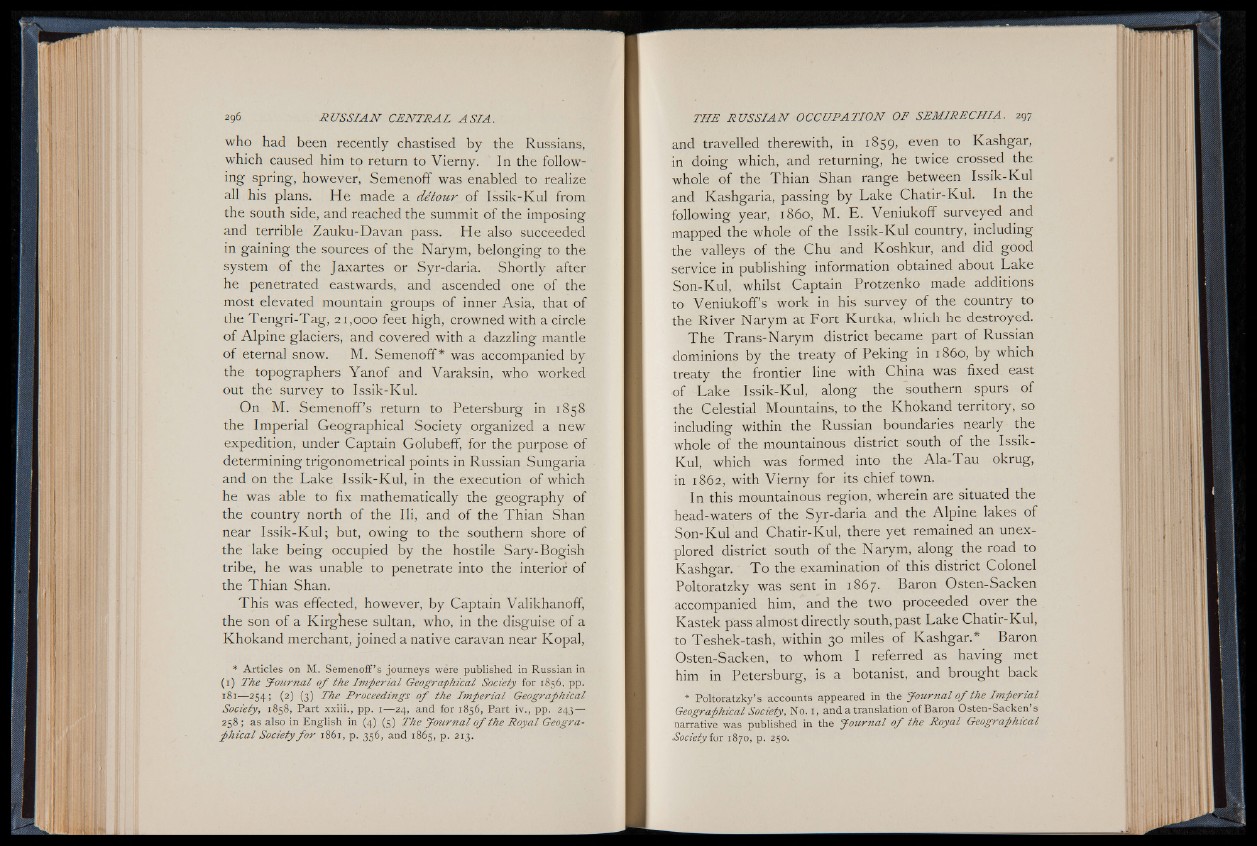
who had been recently chastised by the Russians,
w'hich caused him to return to Vierny. In the following
spring, however, Semenoflf was enabled to realize
all his plans. He made a détour of Issik-Kul from
the south side, and reached the summit of the imposing
and terrible Zauku-Davan pass. He also succeeded
in gaining the sources of the Narym, belonging to the
system of the Jaxartes or Syr-daria. Shortly after
he penetrated eastwards, and ascended one of the
most elevated mountain groups of inner Asia, that of
the Tengri-Tag, 21,000 feet high, crowned with a circle
o f Alpine glaciers, and covered with a dazzling mantle
of eternal snow. M. Semenoff* was accompanied by
the topographers Yanof and Varaksin, who worked
out the survey to Issik-Kul.
On M. Semenoff’s return to Petersburg in 1858
the Imperial Geographical Society organized a new
expedition, under Captain Golubeff, for the purpose of
determining trigonometrical points in Russian Sungaria
and on the Lake Issik-Kul, in the execution of which
he was able to fix mathematically the geography of
the country north of the Ili, and of the Thian Shan
near Issik-Kul; but, owing to the southern shore of
the lake being occupied by the hostile Sary-Bogish
tribe, he was unable to penetrate into the interior of
the Thian Shan.
This was effected, however, by Captain Valikhanoff,
the son of a Kirghese sultan, who, in the disguise of a
Khokand merchant, joined a native caravan near Kopal,
* Articles on M. Semenoff’ s journeys were published in Russian in
(1) The Journ a l o f the Imperial Geographical Society for 1856, pp.
181— 254; (2) (3) The Proceedings o f the Imperial Geographical
Society, 1858, Part xxiii., pp. 1— 24, and for 1856, Part iv., pp. 243—
258 ; as also in English in (4) (5) The Journal o f the Royal Geograp
h ica l Society f o r 1861, p. 356, and 1865, p. 213.
and travelled therewith, in 1859, even to Kashgar,
in doing which, and returning, he twice crossed the
whole of the Thian Shan range between Issik-Kul
and Kashgaria, passing by Lake Chatir-Kul. In the
following year, i860, M. E. Veniukoff surveyed and
mapped the whole of the Issik-Kul country, including
the valleys of the Chu and Koshkur, and did good
service in publishing information obtained about Lake
Son-Kul, whilst Captain Protzenko made additions
to Veniukoff’s work in his survey of the country to
the River Narym at Fort Kurtka, which he destroyed.
The Trans-Narym district became part of Russian
dominions by the treaty of Peking in i860, by which
treaty the frontier line with China was fixed east
o f Lake Issik-Kul, along the southern spurs of
the Celestial Mountains, to the Khokand territory, so
including within the Russian boundaries nearly the
whole of the mountainous district south of the Issik-
Kul, which was formed into the Ala-Tau okrug,
in 1862, with Vierny for its chief town.
In this mountainous region, wherein are situated the
head-waters of the Syr-daria and the Alpine lakes of
Son-Kul and Chatir-Kul, there yet remained an unexplored
district south of the N arym, along the road to
Kashgar. T o the examination of this district Colonel
Poltoratzky was sent in 1867. Baron Osten-Sacken
accompanied him, and the two proceeded over the
Kastek pass almost directly south, past Lake Chatir-Kul,
to Teshek-tash, within 30 miles of Kashgar.* Baron
Osten-Sacken, to whom I referred as having met
him in Petersburg, is a botanist, and brought back
* Poltoratzky ’ s accounts appeared in the Journal o f the Imperial
Geographical Society, No. i , and a translation of Baron Osten-Sacken’ s
narrative was published in the Jou rna l o f the Royal Geographical
Society for 1870, p. 250.